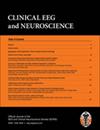T2DM 患者练习瑜伽 12 周后的事件相关电位变化:随机对照试验
IF 1.7
4区 医学
Q3 CLINICAL NEUROLOGY
引用次数: 0
摘要
简介与健康人相比,2 型糖尿病患者更容易出现认知能力下降(1.5%)和痴呆(1.6%)。尽管认知功能障碍对 2 型糖尿病(T2DM)患者有不利影响,但它却是 T2DM 患者最不容易处理的并发症。研究目的本研究试图探讨 T2DM 患者在练习瑜伽 12 周后认知能力的变化以及导致这些变化的可能因素。研究方法本研究是一项平行分组随机对照试验,比较了随机分为瑜伽组(YG)(25 人)和等待对照组(29 人)的参与者的结果。研究评估了干预前后Stroop任务后的N200和N450事件相关电位(ERP)成分、心率变异性(HRV)和HbA1c。结果显示干预后,N200 ERP分量的平均振幅显示出显著的组间差异,表明神经在冲突监控和反应抑制过程中的效率有所提高。N450分量没有差异。T2DM 患者在练习瑜伽后心率降低,平均心率增加,而其他心率变异参数没有相应变化,这表明心脏活动得到了整体改善。此外,瑜伽练习还降低了 T2DM 患者的 HbA1c 水平,表明血糖控制得到了改善。此外,干预后 HbA1c 水平与反应时间呈负相关,表明血糖控制对认知能力有影响。结论为期 12 周的瑜伽练习通过增强冲突监控和反应抑制过程改善了认知能力。此外,干预后认知能力的提高还得益于血糖控制的改善。本文章由计算机程序翻译,如有差异,请以英文原文为准。
Event-Related Potential Changes Following 12-week Yoga Practice in T2DM Patients: A Randomized Controlled Trial
Introduction. Type 2 diabetes patients are more likely to experience cognitive decline (1.5%) and dementia (1.6%) than healthy individuals. Although cognitive impairment adversely affects Type 2 diabetes mellitus (T2DM) patients, it is the least addressed complication of T2DM patients. Objective. The present study attempts to examine the changes in cognitive performance of T2DM patients and the probable factors contributing to the changes following 12-week yoga practice. Methods. The current study is a parallel group randomized controlled trial that compared the outcomes of the participants randomized to a yoga group (YG) ( n = 25) and to a wait-list control group ( n = 29). The study assessed N200 and N450 event-related potential (ERP) components following the Stroop task, heart rate variability (HRV) and HbA1c before and after the intervention. Results. The mean amplitude of the N200 ERP component showed a significant group difference after the intervention, demonstrating an improved neural efficiency in the process of conflict monitoring and response inhibition. No differences were present for the N450 component. T2DM patients showed reduced heart rate and increased mean RR following yoga practice without any corresponding changes in other HRV parameters, demonstrating an overall improvement in cardiac activity. Along with that yoga practice also reduced HbA1c levels in T2DM patients, indicating improved glycemic control. Moreover, HbA1c levels were negatively correlated with reaction time after the intervention, indicating an impact of glycemic control on cognitive performance. Conclusion. The 12-week yoga practice improved cognitive performance by enhancing the processes of conflict monitoring and response inhibition. Further, improved cognitive performance postintervention was facilitated by improved glycemic control.
求助全文
通过发布文献求助,成功后即可免费获取论文全文。
去求助
来源期刊

Clinical EEG and Neuroscience
医学-临床神经学
CiteScore
5.20
自引率
5.00%
发文量
66
审稿时长
>12 weeks
期刊介绍:
Clinical EEG and Neuroscience conveys clinically relevant research and development in electroencephalography and neuroscience. Original articles on any aspect of clinical neurophysiology or related work in allied fields are invited for publication.
 求助内容:
求助内容: 应助结果提醒方式:
应助结果提醒方式:


